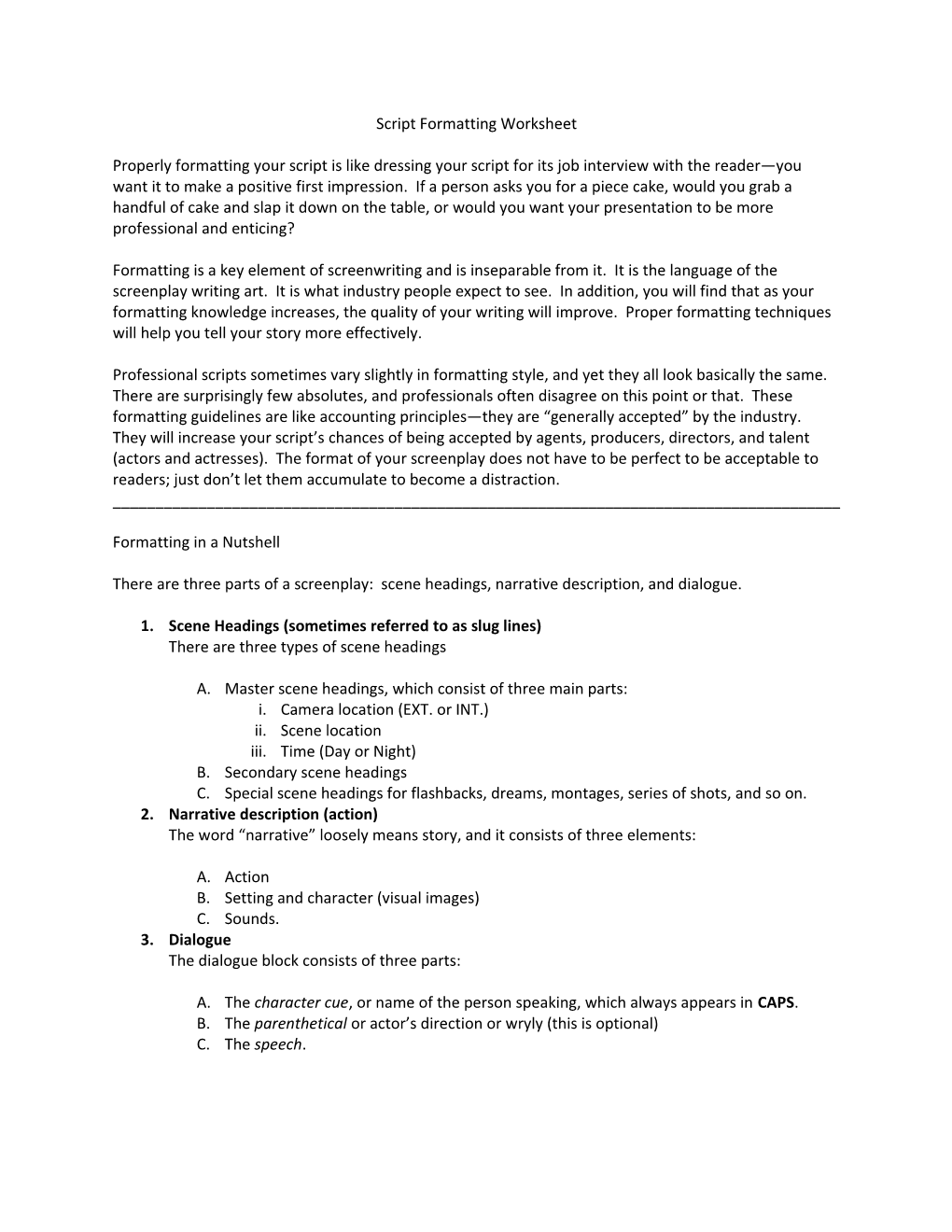Script Formatting Worksheet
Properly formatting your script is like dressing your script for its job interview with the reader—you want it to make a positive first impression. If a person asks you for a piece cake, would you grab a handful of cake and slap it down on the table, or would you want your presentation to be more professional and enticing?
Formatting is a key element of screenwriting and is inseparable from it. It is the language of the screenplay writing art. It is what industry people expect to see. In addition, you will find that as your formatting knowledge increases, the quality of your writing will improve. Proper formatting techniques will help you tell your story more effectively.
Professional scripts sometimes vary slightly in formatting style, and yet they all look basically the same. There are surprisingly few absolutes, and professionals often disagree on this point or that. These formatting guidelines are like accounting principles—they are “generally accepted” by the industry. They will increase your script’s chances of being accepted by agents, producers, directors, and talent (actors and actresses). The format of your screenplay does not have to be perfect to be acceptable to readers; just don’t let them accumulate to become a distraction.
______
Formatting in a Nutshell
There are three parts of a screenplay: scene headings, narrative description, and dialogue.
- Scene Headings (sometimes referred to as slug lines)
There are three types of scene headings
- Master scene headings, which consist of three main parts:
- Camera location (EXT. or INT.)
- Scene location
- Time (Day or Night)
- Secondary scene headings
- Special scene headings for flashbacks, dreams, montages, series of shots, and so on.
- Narrative description (action)
The word “narrative” loosely means story, and it consists of three elements:
- Action
- Setting and character (visual images)
- Sounds.
- Dialogue
The dialogue block consists of three parts:
- The character cue, or name of the person speaking, which always appears in CAPS.
- The parenthetical or actor’s direction or wryly (this is optional)
- The speech.
TYPEFACE
Always use a Courier New 12-point font because it is the industry standard. Prior to the advent of the computer, screenwriters used the Pica typewriter font, which gave each typed character equal widths: thus, every ten typed characters always measured one inch. It also helped retain the “one page equals one minute of screen time” industry standard of the time. And Courier New 12-point fonts do the same today, they even make today’s screenplays look like they were typed on a typewriter.
Virtually all other fonts are proportional fonts. They compress characters together to get more words on a line. With a proportional font, each character has a different width. This document is written in a proportional font. However, the attached script appears in Courier New 12-point so that they look exactly the way they would look in a script.
MARGINS
Because scripts are three-hole punched, the left margin should be 1.5 inches, the right margin 1” inch The top and bottom margin should also be 1” inch each.
TABS
- Dialogue that’s 10 spaces from the left margin (that’s an additional inch in Courier New)
- Character’s name that’s 22 spaces from the left margin
Make sure your lines of dialogue are no wider than 4 inches
TYLER
You look a little lost, is there anything that I can do to help you out.
